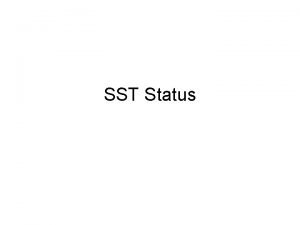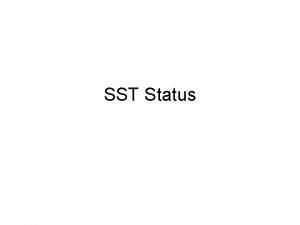SST Status SST Status All SSTs are functioning



- Slides: 3

SST Status

SST Status • • • All SSTs are functioning No electronics failures (12 ADC channels x 5 spacecraft) All attenuators are operating nominally. – automatically closed at high count rate (>20 k. Hz) since April 2008 – Automatically close inside of 8 Re (regardless of count rate) • All ion detectors on all spacecraft are showing noticeable signs of degradation. – – Caused by total accumulated ion implantation over mission lifetime. Results in increase in effective dead layer of incident side of detector. (Each energy channel is shifted up in energy) Degradation rate is not uniform among detectors: • Some detectors are MUCH worse than others – – • • • Spacecraft B&C are the worst Spacecraft E is best Degradation rate is not based on detector production batch. Not dependent on look direction. Appears random. – Not (primarily) due to (penetrating) radiation belt particles. • Commanding error resulted in 4 perigee passes with attenuators left open (summer 2007) but this resulting in only minimal damage. – Primary damage from low energy ions (30 -100 ke. V) that produce recombination centers near detector surface. – Effect was largely mitigated by increase in bias voltage (Dec 2007) on all spacecraft. • Electron detectors do not show obvious detector degradation. – Foils “protect” detectors from intense flux of low energy ions. – Have found an energy dependent reduction in geometric factor. Attributed to “defocusing effect” of low energy electrons scattering in foil away from detectors.

SST Status • Calibration Efforts: – In-flight: • Search for Steady periods of moderately high flux with single energy distribution (as Maxwellian as possible). • Calibration is based on comparison with ESA particle spectrum and extrapolation to higher energy • For Ions: – Use model of dead layer to determine energy shift for each detector (elevation angle) • For Electrons: – Determine relative geometric factor based on comparison with ESA electron spectrum. – Ground Calibration: • Just beginning ion implantation experiment with Jeff Beeman at LBL using ion beam implantation machine. • Modeling electron scattering (defocusing) using GEANT 4




